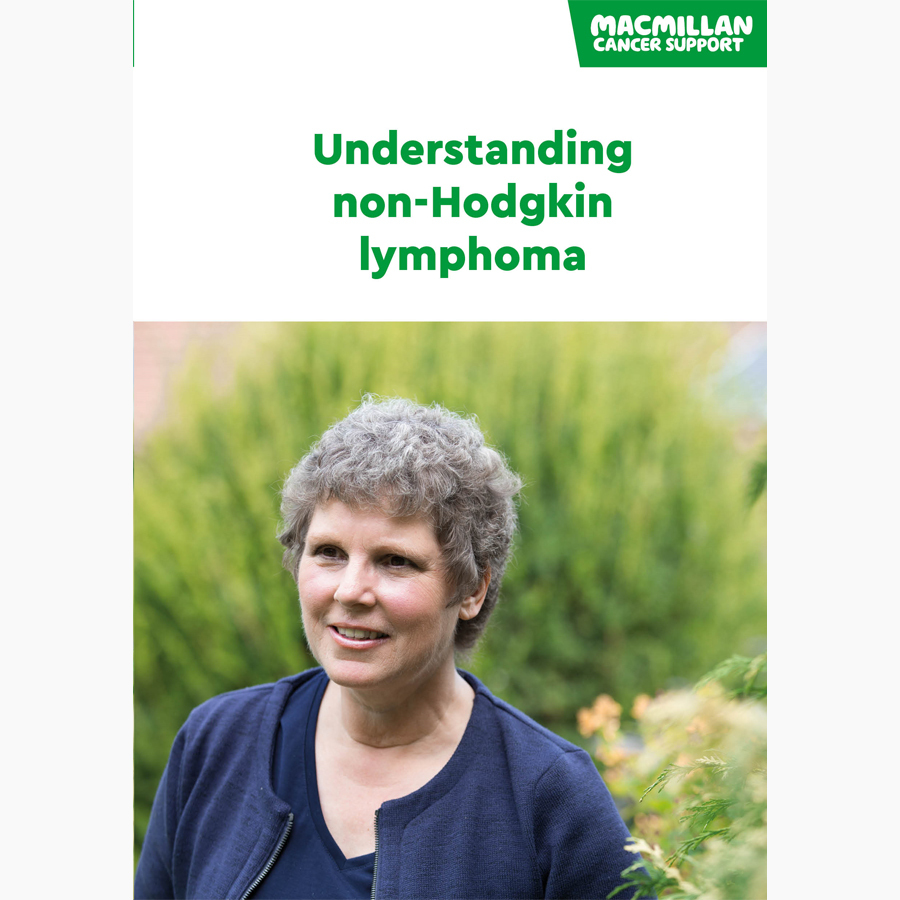What is lymphoma?
Lymphoma is a type of blood cancer. It develops when blood cells called lymphocytes become abnormal.
Normal lymphocytes fight infection. They are part of the lymphatic system. This is the system that helps protect your body from infection and disease. It is made up of fine tubes connected to groups of small lymph nodes throughout the body.
How lymphoma develops and the treatment you may need depends on the type of lymphoma. The 2 main types are:
There are also many different sub-types of lymphoma within these 2 main types.
A doctor can only find out the type of lymphoma you have by collecting some lymphoma cells and testing them. If the sample contains a type of cell called Reed-Sternberg cells, the lymphoma is usually Hodgkin lymphoma. If there are no Reed-Sternberg cells, it is non-Hodgkin lymphoma.
Related pages
Booklets and resources
Lymphoma statistics
Non-Hodgkin lymphoma is the 6th most common cancer in the UK. Around 14,200 people are diagnosed with it each year. It can affect people at any age but is more common as people get older.
Hodgkin lymphoma is less common. Around 2,100 people are diagnosed with Hodgkin lymphoma in the UK each year. Hodgkin lymphoma can happen at any age. It is one of the most common cancers to affect people in their teens and early 20s.
People sometimes search for lymphoma statistics to help them understand what might happen to someone in their situation. This is called prognosis. Doctors cannot predict exactly what will happen in the future. But they may use some of the following types of statistics to help them make an estimate:
- Lymphoma survival rates — this is the number of people who are alive after certain periods of time after a lymphoma diagnosis. It includes people who have no signs of lymphoma and also people who have lymphoma that has come back.
- Lymphoma recurrence or relapse rates — this is the number of people whose lymphoma has come back after certain periods of time after treatment.
- Lymphoma mortality — this is the number of people who have died because of lymphoma during a certain period of time.
You may find this information helpful, but not everyone wants or needs this type of information. Statistics can be worrying and difficult to understand. They may help you understand your chances of a possible outcome. But they do not tell you what will definitely happen to you.
If you want information about lymphoma statistics, or you find numbers online that might apply to you, it is best to talk about them with your cancer doctor or nurse. They can explain:
- which statistics apply to someone with your diagnosis
- what the information may mean to you
- how this may affect any treatment decisions you are thinking about.
Related pages
Symptoms of lymphoma
The most common symptom of lymphoma is a painless swelling or lump in the neck, armpit or groin. This is caused by lymphoma cells building up in the lymph nodes, which makes them bigger.
Some people have other symptoms, depending on where the lymphoma is in their body.
Related pages
Causes of lymphoma
The causes of lymphoma are mostly unknown. But some things may increase the risk of developing it, such as having a weakened immune system.
These are called risk factors.
Having one or more risk factor does not mean you will get lymphoma. Many people with lymphoma do not have any risk factors.
We have more information about:
Diagnosis of lymphoma
If you have symptoms, you usually start by going to your GP. They may arrange for you to have blood tests or scans. Your GP will refer you to hospital for tests and for specialist advice and treatment.
At the hospital, the cancer doctor will ask about any symptoms, your general health and any illnesses you have had. They will also examine you.
If you think you may be pregnant, tell your GP or cancer doctor. Some tests and treatments for lymphoma can be harmful to a baby in the womb. You can usually still have tests and treatment for lymphoma while pregnant. But it is important to talk to your cancer doctor so they can plan your care safely.
Waiting for test results can be a difficult time, we have more information that can help.
In the video below, Dr Ranj is joined by Dr Priya Sriskandarajah to take an in-depth look at lymphoma, exploring its symptoms, stages and treatment options.
Taking a tissue sample (biopsy)
The most important test for diagnosing lymphoma is a biopsy. A doctor or nurse removes a small piece of tissue or a sample of cells from the area of the body they want to check.
Usually this is from an enlarged lymph node. You may have all or part of the lymph node removed. You may have a local anaesthetic to numb the area, or a general anaesthetic and a small operation. Your cancer doctor or specialist nurse will explain the type of biopsy that is best for you.
Tests after diagnosis
You will have more tests before you start treatment for lymphoma. These help your cancer team plan your treatment safely and effectively.
Some tests check your general health and how well your heart, lungs, liver and kidneys are working. This includes blood tests to check:
- the levels of different blood cells in your blood
- whether you have certain infections linked to lymphoma, such as HIV and hepatitis.
Other tests find out more about the stage of the lymphoma. You may have some of the following tests.
-
CT scan
A CT scan makes a detailed picture of the inside of the body. The picture is built up using x-rays taken by the CT scanner.
-
PET or PET-CT scan
A PET scan uses a low dose of radiation to check the activity of cells in different parts of the body. A PET-CT scan is a PET scan and a CT scan together.
-
MRI scan
An MRI scan uses magnetism to build up a detailed picture of areas of the body.
-
Bone marrow biopsy
Bone marrow is spongy material found in the bones. Blood cells are made in the bone marrow. For a bone marrow biopsy, a small sample of bone marrow is usually taken from the back of the hip bone (pelvis). Rarely, the sample is taken from the breastbone (sternum).
-
Lumbar puncture
A lumbar puncture means taking a sample of the fluid that surrounds the brain and spinal cord. This fluid is called cerebrospinal fluid (CSF).
Booklets and resources
Lymphoma staging and grading
Your test results give your cancer team more information about the lymphoma. This includes:
- The stage - staging describes how many areas of your body are affected by lymphoma and where these areas are.
- The grade - grading describes how quickly the lymphoma cells are likely to grow.
Knowing the stage and grade of the lymphoma helps your team plan the right treatment for you.
Lymphoma treatment
A team of specialists will meet to discuss the best possible treatment for you. This is called a multidisciplinary team (MDT).
Your doctor or cancer specialist or nurse will explain the different treatments and their side effects. They will also talk to you about things to consider when making treatment decisions before you agree (consent) to have treatment.
The treatment you have will depend on:
- the type and stage of the lymphoma
- its grade (if you have non-Hodgkin lymphoma)
- the symptoms you have
- which parts of your body are affected
- your general health
- your preferences.
You can find out more in our information about:
After lymphoma treatment
Follow-up after treatment for lymphoma
You will have regular check-ups during and after your treatment. Your cancer doctor or specialist nurse will explain what to expect.
Follow-up appointments are a good time for you to talk to your cancer doctor or specialist nurse about any concerns you have. Tell them as soon as possible if you have any problems or notice new symptoms between appointments. We have more information about follow-up care after lymphoma treatment.
Sometimes side effects may continue or develop months or years after treatment. These are called late effects. We have more information about long-term and late effects of treatment for lymphoma.
Well-being and recovery
It can take time to recover after lymphoma treatment. Some days you may feel better than others.
A healthy lifestyle can help speed up your recovery. Even small lifestyle changes may improve your well-being and long-term health.
Even if you already have a healthy lifestyle, you may choose to make some positive changes after treatment. We have more information on leading a healthy lifestyle after treatment.
Support after lymphoma
People often have many different feelings when they finish lymphoma treatment. You may feel relieved that treatment has finished, but worried about what will happen in the future.
It is important to know where to get support or information if you need it. People often need support even some time after lymphoma treatment. But sometimes it is difficult to know who to ask for help. We have information below about some of the things people ask about after lymphoma treatment. But you may have other questions or need information about something else. To find support:
- ask your GP or someone from your cancer team for advice about support in your area
- find cancer support services near you
- call the Macmillan Support Line for free on 0808 808 00 00
- chat to our cancer information specialists online
- visit our Online Community to talk to people who have been affected by lymphoma, share your experience, and ask your questions.
The HOPE programme is a free 6 session self-management course designed to help you develop techniques and strategies when living with or after cancer. Topics include goal setting, fatigue management, and wellbeing. You can sign up for the online HOPE programme. Or to find out more about face-to-face programmes in your area, email ServiceOpsSupport@macmillan.org.uk.
Other organisations who offer information and support
- Blood Cancer UK offers support and information to people affected by blood cancers, including lymphoma.
- Lymphoma Action provides high quality information and support for people affected by lymphoma. It provides helpline services and a range of peer support including online support meetings, educational events and webinars. Its website includes TrialsLink, a database of lymphoma clinical trials.
More information and advice
We know cancer can affect you physically, emotionally and financially. We have information and advice about different ways cancer might impact you, such as help with:
About our information
This information has been written, revised and edited by Macmillan Cancer Support’s Cancer Information Development team. It has been reviewed by expert medical and health professionals and people living with cancer.
-
References
Below is a sample of the sources used in our lymphoma information. If you would like more information about the sources we use, please contact us at informationproductionteam@macmillan.org.uk
Follows GA, Barrington SF, et al. Guideline for the first-line management of Classical Hodgkin Lymphoma — A British Society for Haematology guideline. Br J Haematol, 2022; 197, 558– 572. [accessed April 2024].
Fox CP, Chaganti S, McIlroy G, et al. The management of newly diagnosed large B-cell lymphoma: A British Society for Haematology Guideline. Br J Haematol. 2024; 204(4):1178–92. [accessed April 2024].
McKay P, Fielding P, et al. Guidelines for the investigation and management of nodular lymphocyte predominant Hodgkin lymphoma. Br J Haematol, 2015; 172, 32-43. [accessed April 2024].
McNamara C, Montoto S, et al. The investigation and management of follicular lymphoma. Br J Haematol, 2020; 191, 363-381. [accessed April 2024].
National Institute for Health and Care Excellence. Non-Hodgkin’s lymphoma: diagnosis and management. NICE guideline [NG52]. Published: 20 July 2016. Last update Oct 2021. [accessed April 2024].
Date reviewed

Our cancer information meets the PIF TICK quality mark.
This means it is easy to use, up-to-date and based on the latest evidence. Learn more about how we produce our information.
The language we use
We want everyone affected by cancer to feel our information is written for them.
We want our information to be as clear as possible. To do this, we try to:
- use plain English
- explain medical words
- use short sentences
- use illustrations to explain text
- structure the information clearly
- make sure important points are clear.
We use gender-inclusive language and talk to our readers as ‘you’ so that everyone feels included. Where clinically necessary we use the terms ‘men’ and ‘women’ or ‘male’ and ‘female’. For example, we do so when talking about parts of the body or mentioning statistics or research about who is affected.
You can read more about how we produce our information here.








